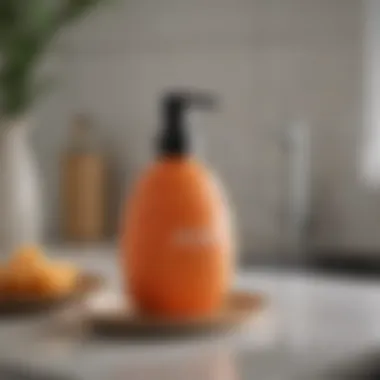Exploring Gorgeous Dish Soap Dispensers for Kitchens


Intro
The aesthetic appeal of a kitchen extends beyond just the cookware and appliances. Following this line of thinking, dish soap dispensers emerge as notable players in enhancing kitchen decor. This article investigates their role, balancing beauty and practicality, in a culinary space. The key elements relate to style, material, usability, and maintenance—all critical to selecting the ideal piece for your kitchen.
Recipe Overview
Purpose of Dish Soap Dispensers
Dish soap dispensers serve as functional tools, yet they also contribute to the visual environment of a kitchen. These dispensers are designed to hold liquid soap and provide a convenient method for cleaning dishes efficiently.
Key Styles and Materials
- Modern Stainless Steel: A contemporary choice that adds a sleek touch.
- Ceramic and Glass: Often adorned with intricate designs, these options can complement various decor styles.
- Plastic: Lightweight and easy to manage, plastic dispensers may offer vibrant colors and patterns.
Practical Considerations
Usability and Maintenance
Selecting a dish soap dispenser involves considering usability. The design should allow easy access to soap while also being user-friendly for all ages. Maintenance is equally important, as certain materials may require more care than others.
- Ease of Refilling: Check how easily the dispenser can be filled.
- Cleaning: Review if the material is dishwasher safe or needs hand cleaning.
- Durability: Look for designs that withstand everyday use.
End
A dish soap dispenser is more than just a utility item; it reflects personal style and enhances kitchen aesthetics. Exploring the diversity in styles and materials helps culinary enthusiasts make informed choices. This thoughtful selection ensures that both functionality and beauty coexist in the heart of their homes.
Foreword to Dish Soap Dispensers
Dish soap dispensers often remain overlooked in kitchen discussions, yet they play a critical role beyond mere functionality. These items serve as important accessories that contribute to the overall design and appeal of kitchen spaces. A dish soap dispenser's design can influence not just the aesthetic of a countertop, but also how efficiently we manage dishwashing tasks in everyday life.
Choosing the right dish soap dispenser involves assessing various factors. Firstly, the style must align with the kitchen's theme. An elegant ceramic piece might complement a rustic decor, while a sleek metal option could enhance a contemporary space. Furthermore, the functionality of these dispensers is crucial. They should allow easy dispensing of soap without creating a mess.
Key Benefits:
- Aesthetic Enhancement: A beautiful dispenser can transform the look of your kitchen.
- Convenience: A well-designed dispenser makes washing dishes simpler and more efficient.
- Durability: Many modern dispensers are designed for longevity, making them a worthwhile addition to your kitchen.
Ultimately, a dish soap dispenser should serve both beauty and utility. This article will explore the various dimensions of dish soap dispensers, examining how they marry aesthetic sensibilities with practical needs, catering to the tastes of food lovers of all ages.
The Role of Functionality and Design
Functionality and design are intertwined when it comes to dish soap dispensers. A dispenser must not only look appealing but also perform its duty efficiently. Poorly designed dispensers can lead to complications in use, such as difficulty in dispensing or unwanted spills.
Factors to Consider:
- Ergonomics: The design should be easy to use, allowing one-handed dispensing if desired.
- Material Choice: Different materials impact both the look and feel of a dispenser, with some providing better grip or ease of cleaning.
- Refill Mechanism: Ease of refilling contributes to overall user experience, making a dispenser more attractive.
"The best dish soap dispensers strike a balance between being visually pleasing and user-friendly."
Selecting a dish soap dispenser thus requires careful thought about both aesthetic preference and practical requirement. As we delve into the various styles and materials of dish soap dispensers, the nexus of form and function will be paramount in guiding our choices.
Aesthetic Considerations in Kitchen Design
A kitchen is not merely a space for cooking; it is a crucial part of a home's aesthetic. Dish soap dispensers, while functional, are also key accessories that can enhance the overall look of a kitchen. These items speak to a balance between beauty and utility, reflecting the owner's style. Beyond mere decorations, they serve practical purposes while also contributing to the visual narrative of the kitchen.
The Visual Impact of Dishware Accessories
The role of dishware accessories, such as soap dispensers, cannot be overstated. They can turn a mundane space into an inviting environment. When carefully selected, these items introduce distinct personality and character. For instance, a sleek ceramic dispenser can elevate a minimalist kitchen, offering a clean and polished appearance.


Dish soap dispensers are not only functional; their placement and design can draw attention or blend seamlessly into the décor. Selecting a dispenser that complements dishware and other kitchen tools is crucial. Accessories that share colors or patterns with dishes create a coherent look.
Key elements to consider include:
- Texture: Matte finishes can be calming, while glossy surfaces can bring vibrancy.
- Shape: Unique shapes can spark conversation and intrigue.
- Size: Large dispensers can become focal points, while smaller ones may serve as subtle accents.
"The right dish soap dispenser can unify the kitchen's visual elements and enhance its charm."
Harmonizing with Kitchen Color Palettes
Color harmony plays a significant role in aesthetic considerations. A dish soap dispenser that aligns with the kitchen's color palette can tie the room together. Choosing colors that complement each other creates a pleasant visual flow that pleases the eye.
Consider the following approaches for harmonizing colors:
- Use of Neutrals: Neutral tones are versatile and can fit into any color scheme, giving off a sophisticated vibe.
- Bold Contrast: A bold-colored soap dispenser can make a statement against a neutral background, creating a striking visual contrast.
- Coordinate with Existing Colors: Matching the dispenser to existing colors in kitchen textiles or major appliances helps integrate the accessory into the overall design.
The choices made regarding color not only affect cohesiveness but also influence the emotional response of those who enter the kitchen. A well-thought-out selection can evoke a sense of calm or energy, depending on the desired atmosphere.
Styles of Beautiful Dish Soap Dispensers
The choice of style in dish soap dispensers plays a crucial role in harmonizing kitchen aesthetics with functionality. A beautifully designed dispenser can effortlessly blend into the kitchen's theme, enhancing the overall visual appeal. Dish soap dispensers have evolved from mere functional items to essential decorative accessories. Emphasizing various styles not only informs consumers of their options but also encourages them to consider how these dispensers can complement their kitchen's atmosphere.
Modern Dispensers
Modern dispensers are characterized by clean lines and sleek designs. They often utilize innovative materials like stainless steel or glass. These choices not only ensure durability but also add a contemporary touch. Many modern dispensers feature pump mechanisms that allow for easy dispensing. This can be particularly useful in busy kitchens, where efficiency is paramount. The minimalist approach to modern designs attracts many consumers seeking a clutter-free environment. The colors are generally neutral, allowing them to blend seamlessly with a variety of kitchen palettes.
Vintage and Retro Designs
Vintage and retro designs invoke nostalgia and charm. They often reflect styles from the mid-20th century, emphasizing distinctive patterns and materials. These dispensers might be made of ceramic, adorned with floral designs or brightly colored enamels. The aesthetic appeal of vintage options appeals to individuals wanting to infuse character into their kitchens. These dispensers can serve as conversation pieces, bringing unique flavor to the space.
Rustic Elements in Design
Rustic designs often incorporate natural materials, such as wood and stone, creating a warm and inviting feel. These dispensers are perfect for kitchens that follow a farmhouse or cottage theme. Rustic options often highlight craftsmanship, with artisanal touches that showcase their unique character. They must also be functional, allowing for easy refills and maintenance. Using a rustic soap dispenser can enhance the natural elements in a kitchen, making it feel more grounded and connected to nature.
Sleek and Minimalistic Options
Sleek and minimalistic dispensers prioritize simplicity and functionality. These designs often emphasize a single color or material, creating a harmonious look that avoids unnecessary embellishments. Their streamlined aesthetics are popular in modern homes where space is a concern. Minimalistic options may also integrate multifunctional features, such as built-in storage compartments for sponges or brushes. These functionalities make them a practical choice for smaller kitchens, where every inch counts.
"The right style can transform a basic kitchen accessory into a statement piece."
In summary, the style of dish soap dispensers greatly influences kitchen dynamics. By offering a range of designs, from modern to vintage, consumers can select an option that best fits their individual tastes and kitchen themes. A thoughtful style choice enhances both functionality and aesthetics, thereby enriching the culinary experience.
Material Considerations for Dish Soap Dispensers
Understanding the materials used in dish soap dispensers is essential for both functionality and aesthetics. The choice of material influences not only the appearance but also the longevity, usability, and maintenance of the dispenser. Different materials offer various benefits, drawing attention for their unique characteristics and how they complement kitchen design.
Glass Dispensers
Glass dispensers stand out for their elegance and transparency. They provide an air of sophistication while allowing an unobstructed view of the soap level. Glass is non-porous, hence easy to clean and resistant to stain, ensuring that it maintains its pristine look over time. One downside is that they can be more fragile compared to other materials. Care has to be taken to prevent breakage, especially in households with children. Additionally, the weight of glass can make these dispensers feel more substantial and luxurious.
Ceramic and Stoneware Choices
Ceramic and stoneware dispensers are favored for their artistic appeal and variety of designs. These materials tend to be heavy, reducing the chance of them tipping over during use. They often come in a myriad of colors and intricate patterns, allowing for personal expression in kitchen decor. However, ceramics can chip, and their porous nature might absorb some soap materials over time, making them more challenging to clean. Ultimately, they serve as both a functional item and a decorative piece in the kitchen.
Plastic Dispensers: Pros and Cons
Plastic dispensers are known for being lightweight and durable. They can withstand drops without shattering, making them a practical choice for busy kitchens. Price is another advantage, as plastic dispensers are often more affordable than their glass or ceramic counterparts. However, one must consider that the quality of plastic varies. Some materials may stain or deform over time, and they can retain odors. Proper care is necessary to extend the life of plastic dispensers.


Metal Options for Durability
Metal dispensers, often made from stainless steel, provide a modern and sleek look. They are resistant to rust and corrosion, offering a long-lasting option for dish soap. The durability makes them ideal for high-usage environments. Moreover, metal can blend seamlessly with various kitchen styles, from contemporary to industrial. The main drawback is the potential for dents, which may affect aesthetics. It is also critical to check for any plastic components that could wear through time.
In summary, choosing the right material for dish soap dispensers involves considering factors such as durability, aesthetics, and maintenance. Every material, from glass to metal, offers distinct advantages and should be selected based on individual needs and kitchen design preferences.
Functionality Versus Aesthetics
When exploring dish soap dispensers, one must consider the delicate balance between functionality and aesthetics. These items are not merely tools for dispensing liquid soap; they serve a dual purpose. A kitchen's ambiance and style can be significantly enhanced with thoughtfully chosen dispensers. However, if these items fail to serve their primary function well, their appeal diminishes considerably.
As the kitchen is often the heart of the home, having a dish soap dispenser that combines both beauty and utility is essential. The focus should be on selecting dispensers that make tasks easier while also fitting seamlessly into the kitchen's design. This balance influences not just user experience but also the overall visual harmony of the space.
Ease of Use and Dispensing Mechanisms
An effective dish soap dispenser should excel in ease of use. One might favor a design that allows for one-handed operation, enabling a smooth workflow while washing dishes. Common mechanisms include pumps, sprayers, and even squeeze bottles, each offering different benefits.
The pump mechanism is especially popular. It allows for controlled dispensing, minimizing mess and preventing excess soap from being wasted. Alternatively, a sprayer might be preferred for flexibility and quick access, especially when cleaning larger pots or pans.
When considering options, think also about the grip on the dispenser. A non-slip surface can be valuable in wet kitchen environments, and ergonomics should play a role in your choice.
Cleaning and Maintenance Considerations
Maintaining a clean dish soap dispenser adds to its functional appeal, but it requires careful consideration. Sometimes, aesthetics can lead to hidden challenges. For example, complex or intricate designs may look beautiful but can harbor dirt or soap scum in hard-to-reach areas.
Glass and ceramic dispensers often need gentle, non-abrasive cleaners, while plastic options can generally be safely washed with standard dish soap. Regular maintenance should also be scheduled to prevent any buildup.
Here are some maintenance tips to consider:
- Regular Cleaning: Wash dispensers at least weekly to avoid buildup.
- Material-Specific Care: Follow care guidelines depending on whether it’s glass, ceramic, or plastic.
- Replacing Parts: Some dispensing mechanisms may wear out or become less effective, requiring replacement or repair.
Effective maintenance preserves the beauty and utility of dish soap dispensers, ensuring they remain both functional and attractive in your kitchen.
In summary, striking the right balance between functionality and aesthetics when choosing a dish soap dispenser is essential. Ease of use and straightforward maintenance will enhance your kitchen experience while ensuring that your choices elevate the area's overall visual appeal.
Eco-Friendly Options in Dish Soap Dispensers
In recent years, a noticeable shift has occurred in consumer behavior, particularly regarding sustainability. As kitchens become a focal point of home life, the demand for eco-friendly dish soap dispensers has risen. Understanding the role these dispensers play is vital, not only in terms of aesthetics and functionality but also in their impact on the environment.
Choosing eco-friendly options encourages responsible consumption and drives the market towards greener alternatives. This section explores the vital materials, benefits, and considerations tied to eco-friendly dish soap dispensers.
Materials and Environmental Impact
Various materials are utilized in the manufacturing of dish soap dispensers, each affecting the environment in differing ways. Glass dispensers, for instance, are often considered more sustainable than plastic. They are reusable, recyclable, and less likely to contribute to pollution or landfill waste when discarded.
Ceramic and stoneware options provide another sustainable avenue. These materials are biodegradable and often made from natural resources. However, the production processes can sometimes result in higher energy consumption when compared to more recyclable materials.
On the other hand, plastic dispensers raise significant concerns. While many manufacturers claim their plastic is recyclable, the reality is that a large percentage still ends up in landfills. To mitigate this, some brands are innovating by using post-consumer recycled plastic, thus reducing the demand for new plastic production and minimizing waste.
In examining the environmental impact these materials have, it becomes apparent that consumers must explore along the lines of durability, usability, and recycling potential.
Sustainable Practices and Usability
Integrating eco-friendly dispensers also means considering sustainable practices in everyday use. Users should prioritize dispensers that emphasize durability and ease of care. Easy-to-clean designs ensure that consumers can maintain hygiene without reliance on harsh chemicals, promoting longevity in both the dispenser and the soap used.
Furthermore, customization options, such as refilling programs, help to reduce waste. Many brands are now implementing refill stations, making the transition to a more sustainable kitchen routine seamless.
"By making thoughtful choices in kitchen accessories, we contribute to a larger conversation about sustainability and environmental responsibility."


These practices not only align with an eco-conscious lifestyle but also resonate deeply with food lovers who appreciate the beauty and functionality of their kitchen essentials. Selecting an eco-friendly dish soap dispenser is not merely a personal choice but a statement about values and commitment to sustainability.
Selecting the Right Dish Soap Dispenser
Choosing the right dish soap dispenser is pivotal for both functionality and aesthetics in your kitchen. This section explores how a well-chosen dispenser not only enhances the visual appeal of your kitchen but also contributes to seamless usability during daily tasks. It encourages readers to consider their specific needs and preferences, ensuring that their choice aligns with both personal style and practical requirements.
Assessing Kitchen Space and Design
When selecting a dish soap dispenser, the first step is assessing your kitchen space and overall design. The dimensions and layout of your kitchen can greatly influence your choice of dispenser. Take note of countertop space, movement flow, and accessibility. For smaller kitchens, compact designs may be ideal. A taller, slender dispenser can save room while still being functional.
Consider the style of your kitchen as well. In a modern kitchen, a sleek dispenser made of metal or glass may blend seamlessly. In contrast, a more rustic kitchen might benefit from a ceramic or wooden option, echoing other design elements. This step is crucial as it sets the foundation for making an informed choice that complements your kitchen’s environment.
Aligning Personal Style with Kitchen Decor
The next critical aspect is aligning the selected dispenser with personal style and kitchen decor. Dish soap dispensers come in various styles, from minimalist to ornate, ensuring there is something for everyone. Think about the colors and textures that already exist in your kitchen. If your decor features bold colors, a more neutral dispenser can provide balance.
Also, consider the finishes. For example, if your kitchen showcases chrome fixtures, a similar metallic dispenser can create a cohesive look. Conversely, if the kitchen is designed in warm tones, a ceramic option with earthy colors might be more suitable. Taking time to align your dispenser choice with your existing decor promotes a harmonious aesthetic.
Budget Considerations in Choosing Dispensers
Finally, budget considerations must not be overlooked when choosing a dish soap dispenser. Prices for dispensers can vary widely, influencing the selection process. Set a reasonable budget that fits within your overall kitchen expenses. Sometimes, investing slightly more in a quality item pays off in durability and style.
Evaluate the important features such as material, design, and brand reputation when considering cost. Glass or ceramic dispensers can tend to be more expensive but may offer a distinct look and feel. On the other hand, plastic options may be more affordable but can lack the same visual charm.
Choosing the right dish soap dispenser requires a balance between aesthetic appeal, functional usability, and a defined budget. By carefully considering each of these elements, you will select a dispenser that enhances your kitchen's beauty while maintaining practicality.
Trends in Dish Soap Dispenser Designs
As kitchens evolve into spaces that blend aesthetics with practicality, dish soap dispensers are no longer relegated to mere functionality. Instead, they now serve as focal points that reflect individual style and complement the environmental ambiance. Understanding the current trends in dish soap dispenser designs can greatly enhance the overall space, allowing culinary enthusiasts to make informed choices while keeping their kitchens both beautiful and efficient.
Innovations in Kitchen Accessories
Innovative designs in kitchen accessories have revolutionized how we view standard items, including dish soap dispensers. Modern solutions incorporate technology and smart materials. For instance, touchless dispensers equipped with sensors allow for hands-free operation, promoting hygiene and convenience. Another notable innovation is the use of refillable containers, which significantly reduce plastic waste, resonating with sustainable living trends.
The integration of multifunctionality has also gained traction. Some dispensers now combine soap dispensing with dish scrubbers, all in one streamlined unit. This not only saves counter space but also adds a sleek appearance that modern kitchens often showcase. As eco-consciousness rises, many brands are focusing on biodegradable materials and designs that promote longevity, appealing to a growing consumer base that prioritizes sustainability.
Personalization and Customization Trends
Personalization in dish soap dispenser designs fosters a unique kitchen environment that echoes personal tastes. Current trends show that consumers appreciate the option to customize their dispensers. This customization can include a variety of colors, patterns, and even personalized engravings that can reflect individual lifestyles or seasonal changes.
Furthermore, custom designs lead to better harmony with the overall kitchen decor. Instead of choosing a generic product, individuals can select dispensers that mirror their design aesthetic, whether that be rustic, minimalist, or even eclectic styles. This trend also extends to providing consumers with a choice of materials that complement their specific kitchen theme, thus making the dish soap dispenser not just a tool, but a statement piece that enhances both beauty and utility.
"Today’s dish soap dispensers exemplify how functional items can seamlessly integrate into our living spaces, enhancing both usability and aesthetics."
Ultimately, the trends in dish soap dispenser designs reflect the dynamic nature of modern kitchen culture. They signify a shift towards a more thoughtful approach to kitchen ware, where every item serves a purpose beyond utility. Embracing these trends allows for a more cohesive and appealing kitchen environment.
Final Thoughts on Dish Soap Dispensers
Dish soap dispensers serve a unique purpose in today's kitchens. They harmonize functionality and aesthetics, offering both convenience and a decorative touch.
The article has explored various aspects of dish soap dispensers, highlighting their significance beyond just a practical tool. These dispensers play an essential role in enhancing the overall look of a kitchen. They come in various styles, materials, and designs, catering to diverse tastes and preferences. When selecting a dispenser, it is important to consider how it aligns with the kitchen's decor and how it reflects personal style.
The Intersection of Beauty and Utility
In evaluating dish soap dispensers, one must recognize their dual role as both beautiful objects and functional items. The utility of a good dispenser is evident in its ability to dispense soap easily and efficiently. However, beauty should not be overlooked. An aesthetically pleasing dispenser can transform mundane dishwashing into a pleasing visual experience.
Key benefits of considering both beauty and utility include:
- Enhanced kitchen decor: A stylish dispenser can complement or elevate the design theme of a kitchen.
- Increased usability: Dispensers designed for effortless use contribute to a smoother dishwashing experience.
- Sustainability: Many modern designs focus on eco-friendly materials without compromising aesthetic appeal.
In summary, an ideal dish soap dispenser blends attractive design with practical functionality. This intersection ultimately defines the appeal of these everyday kitchen tools. When selecting a dispenser, one should prioritize both aesthetics and usability. A thoughtful choice can elevate the kitchen's atmosphere and enhance the overall dishwashing routine.
"Beautiful dish soap dispensers can transform a common kitchen necessity into a noteworthy design element."
By understanding these considerations, food lovers of all ages can make informed choices when selecting dish soap dispensers that suit their kitchens.







